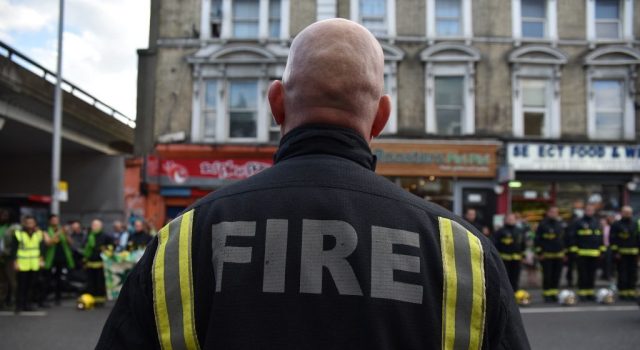Grenfell Tower, one year on. Credit: Alberto Pezzali/NurPhoto via Getty Images

The locals were always a bit suspicious of the Grenfell Public Inquiry. How could a privileged, white, male judge with a double-barrelled name know what it was like to live in an area like the Latimer West estate? Why was the Inquiry located in Holborn, such a long way from that estate in north Kensington? Why was it taking so long? Would it be an establishment stitch-up?
So when it was finally published, the report on Phase 1 of the Inquiry took people by surprise. Far from the whitewash many had feared, it went further than any had dared hope. Even though the media spotlight immediately fell on the report’s criticisms of the London Fire Brigade, the most significant finding was in fact, that, at the time of the fire, the external walls of the building failed to comply with statutory building regulations.
As that chorus of accusatory voices busily castigated the LFB, there were some who argued in their defence, including Jeremy Corbyn, saying that the Inquiry should have started with an investigation into the bodies responsible for making and applying the cladding to the building. However, if it had done it that way round, then those manufacturers and contractors would surely have been just as indignant, arguing that if the LFB had changed their stay-put policy earlier, then fewer people would have died. If the finger points at me, I will quickly point it at someone else to deflect the blame.
That’s why this finding is a game changer. It means that Phase 2 of the inquiry, rather than leaving open the question of whether the building complied with regulations or not, will start from the assumption that it was faulty. It will immediately set out to determine who exactly was responsible for the hazardous state in which the tower stood on the night of 14 June two years ago.
People died in Grenfell Tower because of a tragic and complex series of causes. They include the electrical fault in the fridge freezer, the stay-put advice of the LFB, the material used to make the cladding, the lack of proper regulation to prevent it being used, fire doors and extractor fans that didn’t work properly, and numerous other factors which have only now begun to emerge.
Because the causes are many, responsibility will surely be dispersed. It seems likely that there was no one person or body guilty for it all, but each strand of what caused the fire will end up leading to the door of a person responsible. The temptation in such a situation, as we have seen in recent weeks, is to try to shift the fault onto someone else. Out of fear of loss of face, we are as quick to blame others for their mistakes as we are to hide our own.
Matthew Syed’s book, Black Box Thinking contrasts the approach of the medical profession with the aviation industry. Too often, when a mistake is made in the world of healthcare, the instinct is to cover up failure for fear of litigation, or in order to protect reputations. As a result, he suggests, the same mistakes are often repeated, which means that thousands of people continue to die in hospitals every year due to preventable error.
When a plane crashes, however, the ‘black box’ is recovered, data painstakingly analysed, and no stone is left unturned in order to determine the exact causes of the disaster to make sure that it never happens again. As a result, plane travel has become one of the safest means of transport we have.
The moral of Sayed’s story is that failure is not something to be feared, rather an opportunity to change and improve. It is the individuals and institutions with the resilience and flexibility to face up to failure, learn the lessons and to be open to change which ultimately excel. It is what the Christian church calls repentance — the willingness to admit when we have got something wrong, bear the consequences, ask for forgiveness, resolve to learn from the error of our ways and to become a better person through it. Repentance is not wallowing in self-pity or hiding in a corner from the wagging finger of guilt; it is an invitation to honesty, to growth and to transformation.
This is exactly what is needed as the story of Grenfell unfolds. No doubt over the coming months, that wagging finger will also be pointed at those who were in government before the fire, the Royal Borough of Kensington and Chelsea, the Tenant Management Organisation that was responsible for the building, the manufacturers of the cladding, the contractors who installed it, and many more.
But rather than deflecting the blame onto another party, as we are all tempted to do, what if those who bear some responsibility for the tragedy were to make the choice to see Grenfell as, yes, a tragedy, but also an opportunity to be honest about mistakes?
What if all parties were to learn from it so that it could be ensured that such an event becomes far less likely in future. Not only would they improve as institutions, but also, finally, those who have been most deeply affected by this scar on our national life might find some peace and reassurance that their painful struggles have not all been in vain.










Join the discussion
Join like minded readers that support our journalism by becoming a paid subscriber
To join the discussion in the comments, become a paid subscriber.
Join like minded readers that support our journalism, read unlimited articles and enjoy other subscriber-only benefits.
Subscribe